Blog
December 6th, 2009
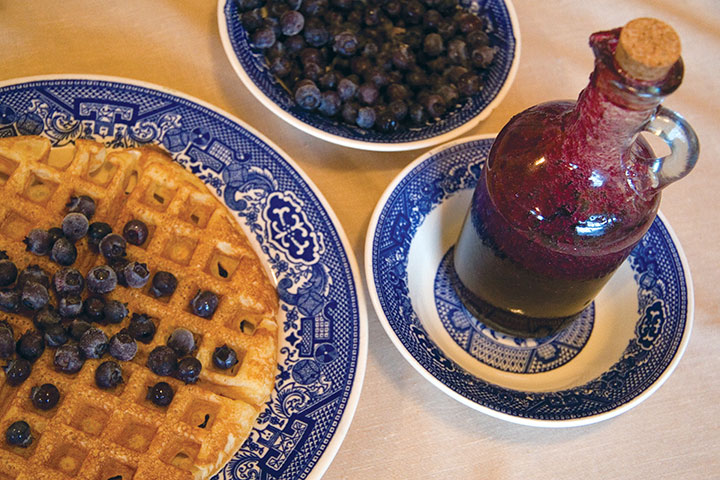
For months now we’ve been finding new ways to use our stores of dried, home-canned and preserved blueberries. But we almost forgot about the containers of fresh berries we threw in the freezer—and on this unseasonably cold* morning, whipping up a little reminder of summer seemed like a good idea.
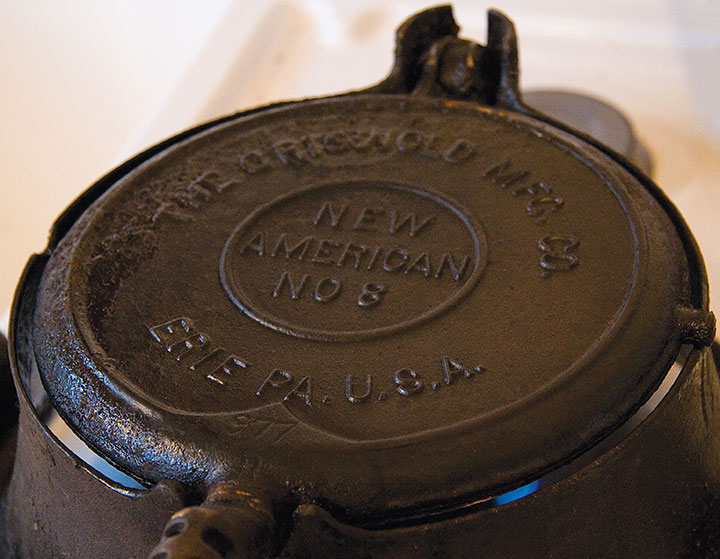
So the Tailor fired up the Cast-Iron Stovetop High-Collared No. 8 Griswold Waffle Iron™ (say that five times fast!), and we had ourselves a good old-fashioned hot breakfast—which, incidentally, goes great with the homemade blueberry syrup above, but the Tailor won’t share that recipe, I’m afraid.
No-Kiddin’ Waffles
2 ¼ cup flour
4 tsp. baking powder
¾ tsp. salt
1 ½ Tbsp. sugar
2 eggs, beaten
2 ¼ cup whole milk
½ cup oil (we use Canola)
Sift the flour, baking powder and salt three times, then add the sugar. In a separate bowl, mix the beaten eggs, milk and oil. Add this to the dry ingredients and mix thoroughly. While some people like to make their batter ahead of time, we’re firm believers in using fresh-fresh-fresh batter. So for best results, make your waffles right then and there.
Oil your cast-iron waffle iron well before starting. Heat both sides of the iron thoroughly (the advantage of a high-collared iron like this is even heating and plenty of room to flip waffles), and remember to apply oil after every third or fourth waffle—a bristle brush is handy for this.

Use a 1/2 cup measure to dip batter—one dip per waffle—and pour the batter into the center of the iron. When you close the lid, the batter will wick evenly into all the nooks and crannies.
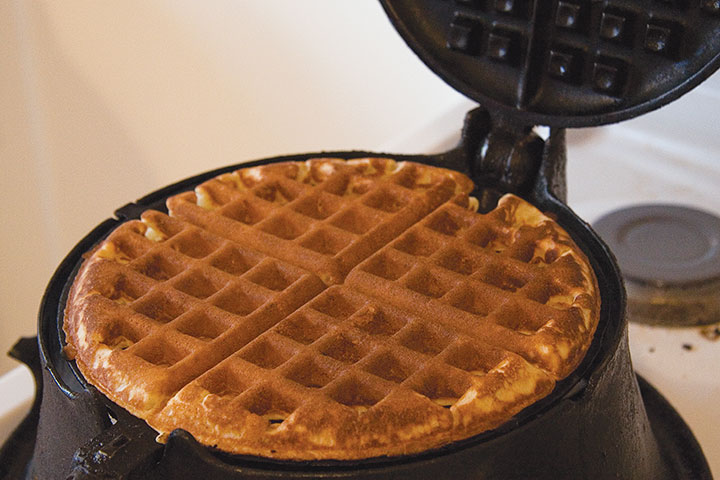
Cook the waffle for 3-4 minutes (peek occasionally to make sure your iron isn’t too hot!), flipping frequently—every thirty seconds or so. The best part (other than the flipping, that is)? Waffles are kind of like pizza—you can jazz them up however you like with your favorite breakfast condiments. But eat ’em fast—a jazzed-up waffle will get cold and soggy** before too long.
That’s never a worry around here, though—these babies get gobbled up long before the next waffle is ready!
• •••••••• ••••••••• ••••••••• ••••••••• ••••••••• ••••••••• •••••••••
* I know all you Minnesotans are rolling your eyes at this declaration, but a nighttime temperature of 17°F is enough to force us to rescue our squash colony from the attic, which isn’t insulated for “real” winter. So until the attic temperature stays above freezing, our pumpkins and butternuts are living in the spare bedroom like edible houseguests—definitely one of the less glamorous aspects of living seasonally.
** I’m really into the specific heat of foods. Mashed potatoes? High specific heat. Fresh waffles? Sadly low.
December 2nd, 2009

Reason number 6,792 why I love it here.
November 26th, 2009
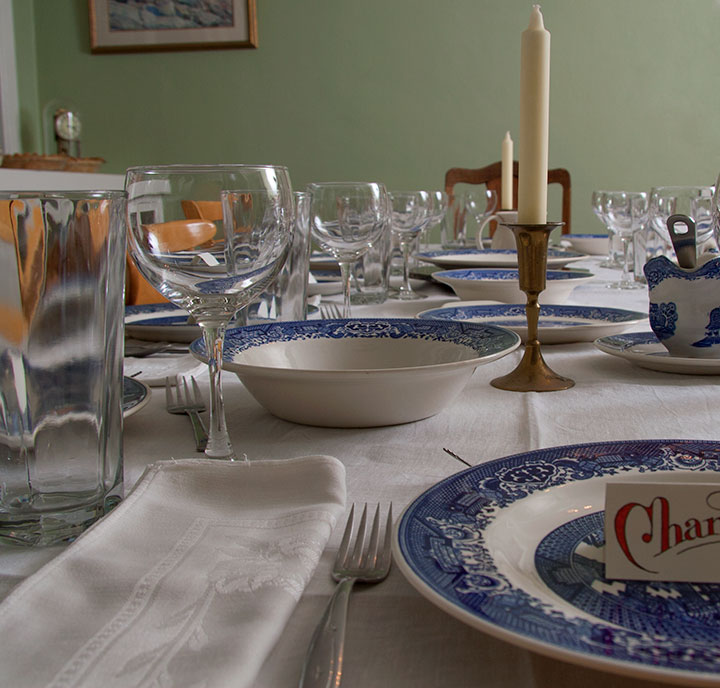
Today I am thankful for the new and old friends who surround me today; for the contrast between the wet Northwestern chill outside and the cozy warmth inside; for the beauty that is so easy to find ’round these parts; and for you. Thank you for joining me here in my little virtual space.
Happy Thanksgiving.
November 20th, 2009

People who stop by the house for the first time must really think I’m strange. Never mind our own personal farmers market residing in the attic and root cellar—these days the place looks like the the visual-art equivalent of Willy Wonka’s Chocolate Factory, with snips of paper, rows of identical bird portraits, bright watercolor cakes, brushes and pencils, boxes of envelopes, shipments waiting to go out, and stacks of prints covering every horizontal surface. It certainly gives new meaning to the term “cottage industry.” I guess that’s what happens when you decide to double your inventory right before the holidays.
This week, though, there was a new element to the chaos: the drone of the sewing machine. And now that all the threads are tied off, Jessica and I are finally ready to unveil a little secret we’ve been sitting on for a few months. Seattle Center for Book Arts (SCBA) asked us to create their second-annual Special Edition Print, and I’m happy to report that they’re now available for sale.

Each year the Special Edition Print has the theme of “Unbound,” and the folks at SCBA challenged us to interpret it how we liked. So instead of our customary work with famous quotes, Jessica whipped up a little gem of her own. We started thinking about all the ways something (not just a book!) might be bound or unbound, which led us to visions of lacing, pinching, tying, zipping, braiding, taping, clamping, buttoning, stitching, buckling, hammering, gluing, clipping, lashing and pinning. Which then, of course, gave me free reign to make an absolute, giddy mess of things, and scatter fasteners and notions all over the page. My favorite additions to the drawing, though, are the bread tags. My grandmother had a whole drawer full of them in her kitchen (did she ever use them, or did I just discover the source of my pack-rat tendencies?), and I loved the way they rattled around in there. So Nana, this one is for you.
Everything is hand-drawn and lettered (as per usual), then letterpress printed in copper ink and an ochre color that is precisely the shade of those little Bit o’Honey candies (remember those?). This time, though, we’ve added a little extra goodie: a line of zig-zag stitching in cotton thread, in exactly the green of copper patina. SCBA is the only place to get these prints, so if you’d like to play a little game of Button, Button, Who’s Got the Button, you can get your copy here.
November 10th, 2009
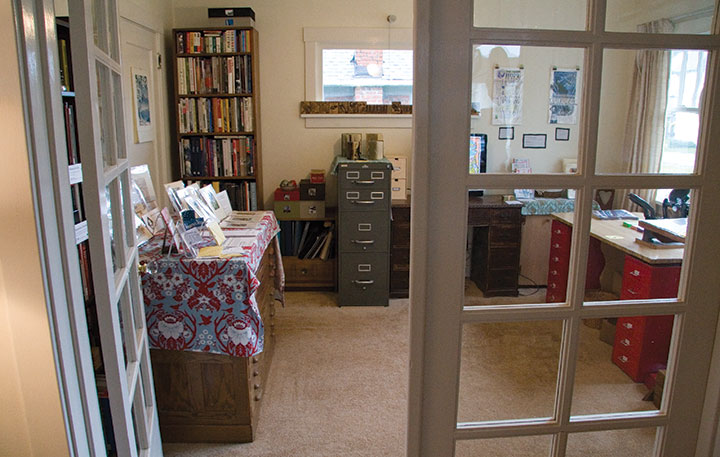
Yowsa! When Tacomans say they’re into art they’re not kidding. Despite absolutely horrendous weather, we had 130 visitors to the studio this weekend! (Hmm…which, oddly enough, is almost exactly the square footage of the space. This is how things looked before that first knock on the door Saturday.)
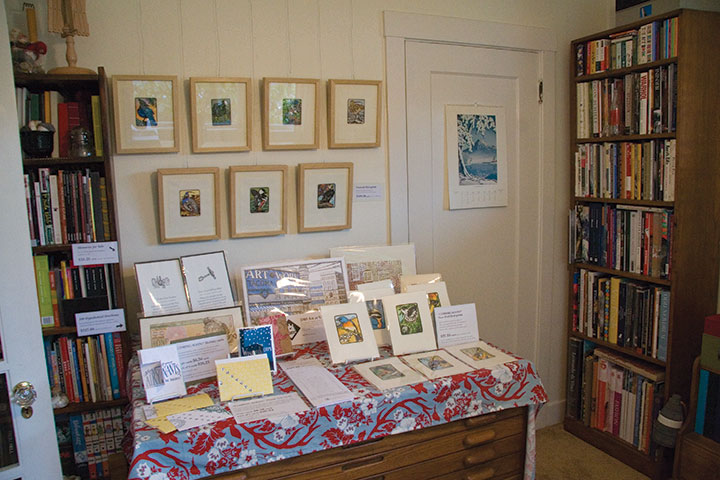
So a vast, colossal thank you is in order for all of you who braved the downpour and jet-propelled ice pellets to get here, and then shoehorned yourselves into the studio to order prints, start a subscription, get your hands dirty on press, or just say hello (sorry the Tailor’s fabulous cookies ran out so quickly). Friends stopped by for a quick hug, gaggles of kids discovered the joys of printing, and one person immediately ran out and bought her own Kelsey press that very same day (you know who you are!), courtesy of Tacoma’s Antique Row. Lots of people returned the second day, and I lost count of all the newcomers and fresh faces. Everybody came with intelligent questions and thoughtful insight, and I’m just overwhelmed by all the kind words of welcome and encouragement. And as if that weren’t gratifying enough, when we finally closed up shop on Sunday, everything was just as tidy as it was on Friday night—no mud tracked in, no prints out of place, no ink straying beyond the demo table. You people are amazing! Sign me up for next year.
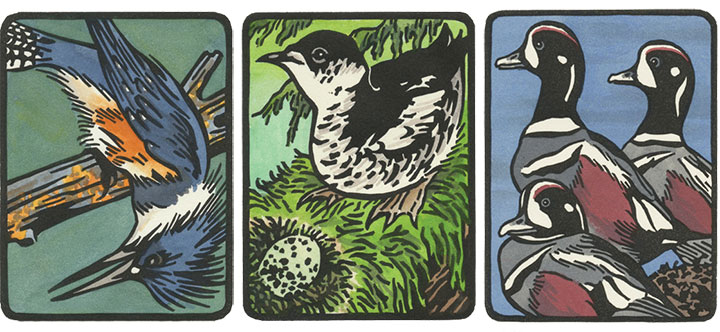
In the meantime there’s still quite a lot of finishing-up to do before the holiday rush consumes my brain (I’m still not over the weird sensation of being on the other end of holiday retail). I’m going to hold onto Marie Curie until Thursday so I can tie up some other loose ends first, so look for it online then.
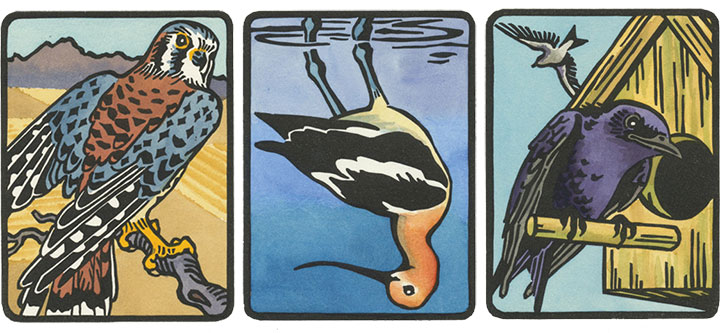
For now, here’s a quick peek of the new birds that were unveiled this weekend. I’m still finishing up the editions (you should see my little watercolor assembly line), so if you placed an order at the studio tour, I’ll be contacting you in the next couple of weeks.
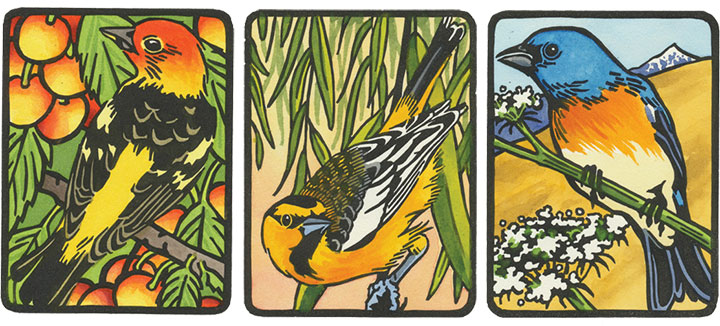
If you’re local but you missed out on the tours this weekend, these little guys will be available at the next Tacoma is for Lovers Craft Fair, held at the inimitable King’s Books on Sunday, November 22, from noon to 5 pm. And for the online world, I’m posting them one-at-a-time, every couple of days in the Etsy shop—just so I don’t get too far ahead of myself!
November 5th, 2009
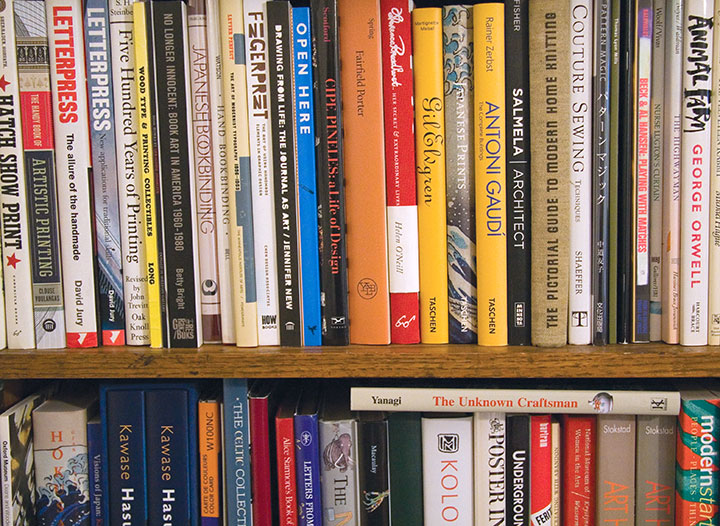
One of the biggest highlights of Tacoma’s annual Art At Work Month is the huge, city-wide Studio Tour circuit, when artists of all stripes (painters, sculptors, printers, photographers, dancers, weavers, jewelers, glassblowers, etc.) open their work spaces to the public and share their processes and products. This year (the eighth year of the event!) there are 39 stops on the tour, and yours truly is joining in on the fun.
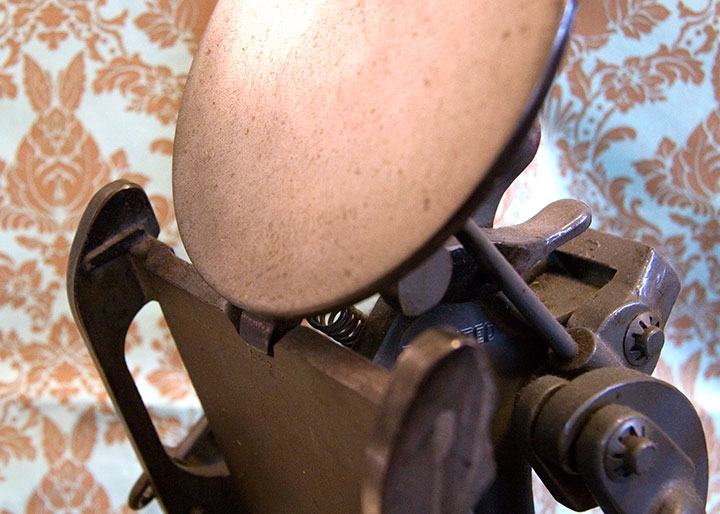
I’ll be firing up the little Kelsey press, so stoppers-by can print their own keepsake and catch the letterpress bug (watch out, it’s contagious!),
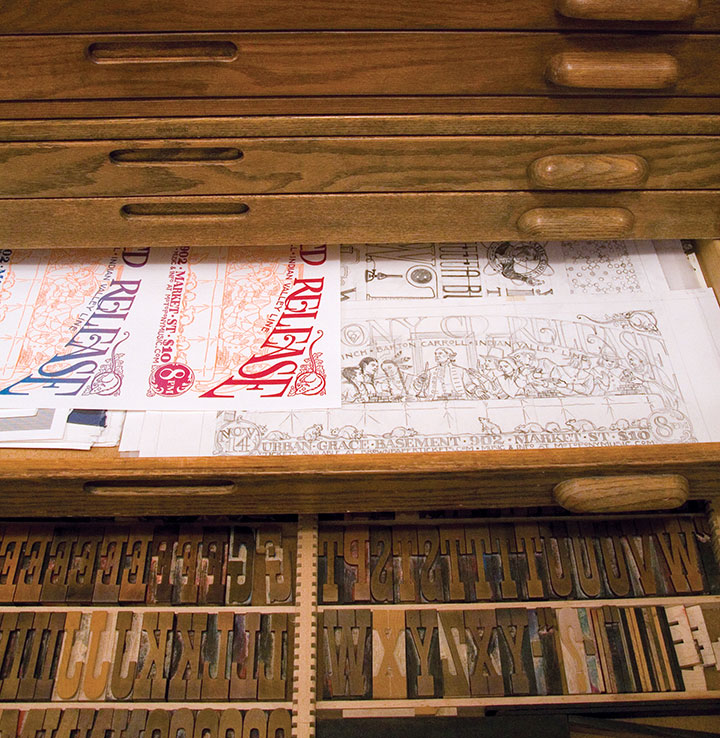
and I’ll have lots of sketches, layouts, tools, and other process materials on display. This is the best part for me, since letterpress and artist books always bring up a lot of questions, and this time I’ll have plenty of visual aids at hand.
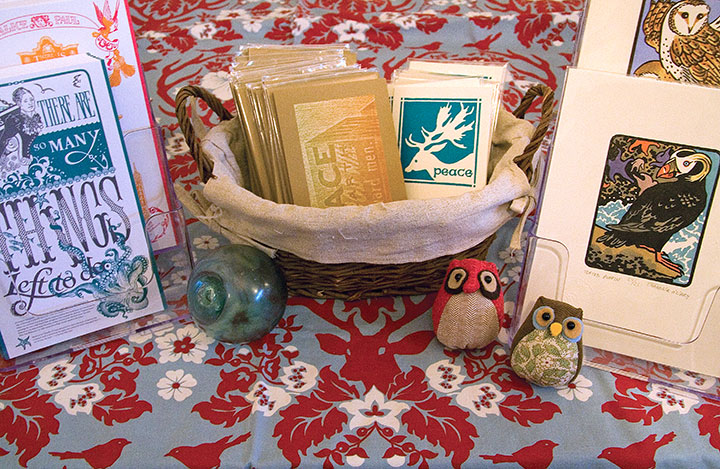
(Stuffed owlets by Mirka Hokkanen, another studio tour artist!)
And since the holidays are just around the corner (or already here, if you believe the Christmas muzak blaring at the grocery store; I proudly promise that Anagram Press will be a carol-free zone), there will be all kinds of goodies for sale, including a boatload of brand-new items. I’ll have copies of the Art At Work poster, a preview of nine (!) new bird prints and several holiday card designs to pre-order, and the unveiling of the newest Dead Feminist broadside. Jessica and I are featuring Marie Curie and the issue of health care this time—but that’s all we’ll share for now. Look for photos and details online next week, but if you want a head start and first pick, you’ll have to come to the tour!
Jessica will be on the tour circuit, too, at her magnificent studio Springtide Press—where she’ll be manning the Vandercook, churning out all kinds of surprises.

So grab an umbrella, ’cause it’s going to rain (are you surprised?), and take a walk around the neighborhood—Anagram Press and other participating studios will be open from 10 am to 4 pm, this Saturday and Sunday, November 7 and 8. And best of all, the event is free and open to everyone! This is my first time participating in the Studio Tours (Alec Clayton from the Weekly Volcano included me in his list of “must-see studios,” so now I’m officially nervous), so please bear with me while I work out the kinks of hosting a hundred or so guests in my little space—I’ll do my best not to run out of munchies or keepsakes. Come on by and say hello.
November 2nd, 2009
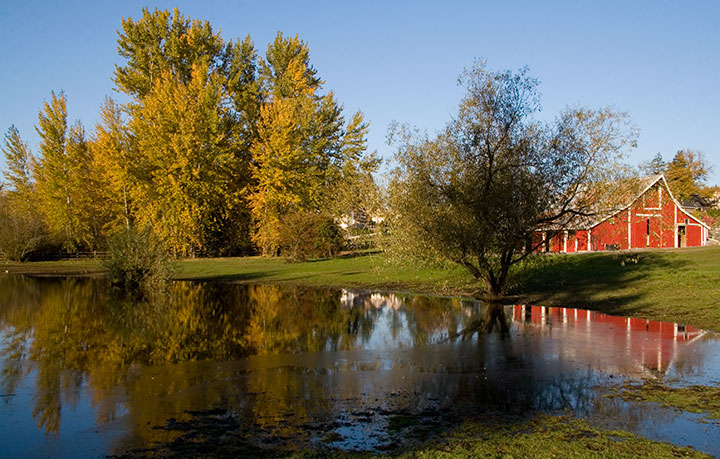
Sunny days are getting fewer and farther between around here, and Mt. Rainier is M.I.A. more often than not. So the gorgeous weather and the threat of an early nightfall (thanks to the end of Daylight Saving Time and living at 47.25° N latitude) were enough to coax me out of the studio and into the car, in hopes of capturing another image for my book.
As far as research goes, the day was a total bust (the Mountain was glorious; I just couldn’t find the right vantage point), but I did come away with an expanded mental map and one good shot.
October 27th, 2009
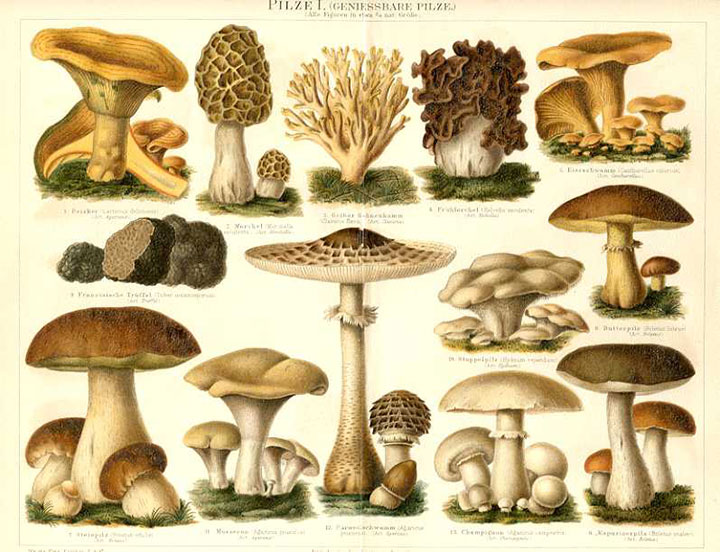
Now that we live in a vacation destination, we tend to get a lot of out-of-town visitors. We have a list of favorite places to take first-timers, so we can often be found at places like the Pike Place Market, Point Defiance, and Mt. Rainier with house guests in tow. When a pair of French foodies arrive on your doorstep, however, it’s a whole ‘nother ballgame. Our friends Gilles and Jean-Philippe had just one major request for their visit last weekend: mushroom hunting. Since it’s chanterelle season and the weather was good, Saturday seemed like a good day to lace up our hiking boots and grab our pocket knives.
Disclaimer! The Tailor and I are not experienced mushroom gatherers, so we’d never try this on our own—incorrectly identifying edible fungi is not a mistake one wants to make. Even the most detailed books can’t replace the presence of a skilled guide, so if you don’t have your own French mycophile on hand to take you hunting, skip the risk and buy a bag of chanterelles at the farmers market!
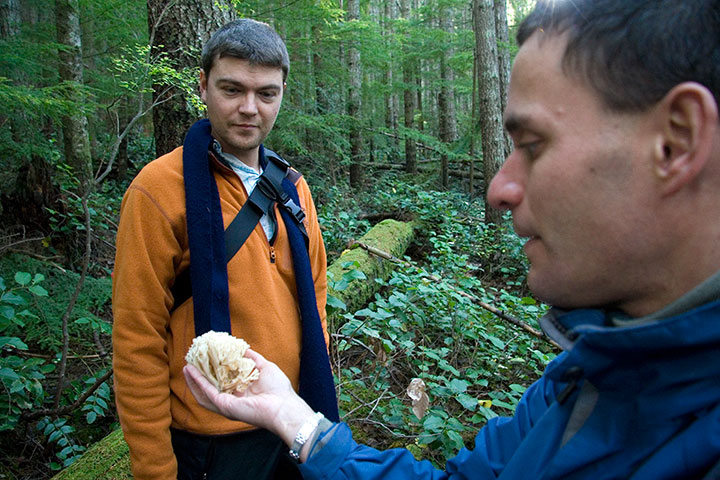
As far as dinner ingredients go, we came away empty-handed—the conditions just weren’t right. But as a crash course in the sheer diversity of local fungi, it was a spectacular day; we found several dozen different varieties ranging from beautiful to bizarre; delicate to disgusting.

We did find a few edible species (these orange peel cups were a beautiful and exciting highlight), but nothing worth turning into a meal. So the day turned out to be more of a scientific field trip—certainly a worthwhile adventure in its own right.
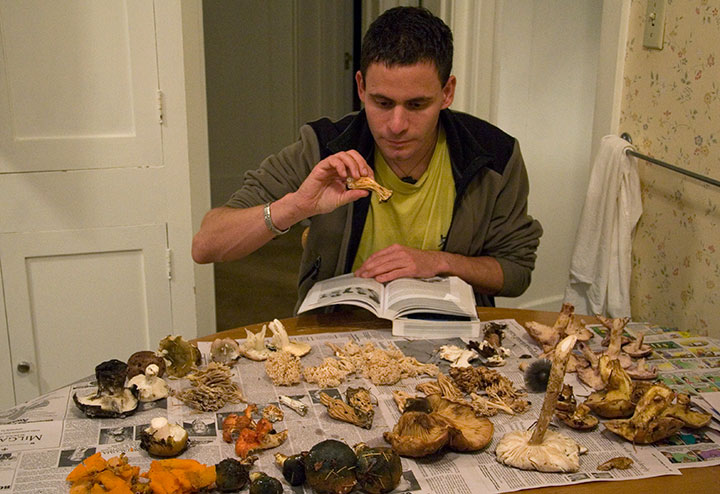
When we got home, Gilles spread out our haul and set to work identifying, making us laugh whenever he called out something strange (stinkhorn, elfin saddle, hedgehog—called sheep’s foot or pied-de-mouton in France).
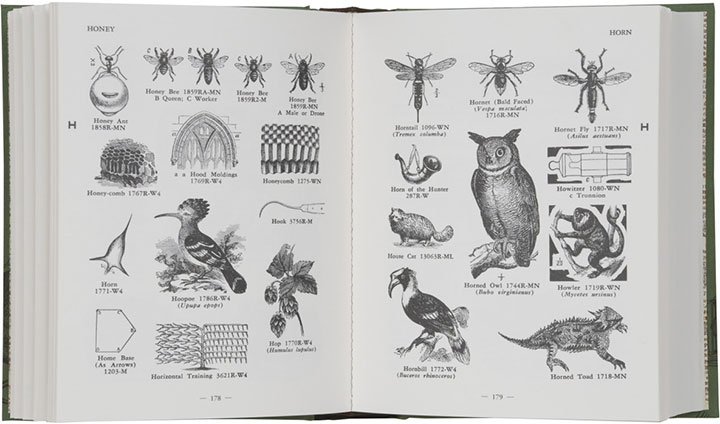
As for me, all this mushroom-naming reminded me of the newest addition to my reference library: the stunning Pictorial Webster’s, by book artist John Carrera (for a mind-blowing art experience, check out the video on the process behind the book here). So I took a page out of his book (sorry, I couldn’t resist), and did a little visual taxonomy of my own.
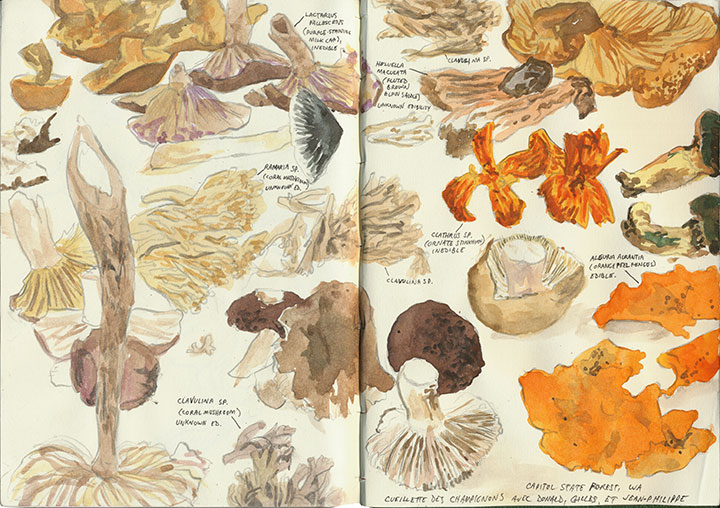
Jean-Philippe, meanwhile, had the best idea yet: purchasing a pound or two of fresh chanterelles, and putting his mad French cooking skills to work. The sumptuous champignons dish he whipped up disappeared into our mouths long before I thought to grab the camera, but I did remember to ask for the recipe:
Chanterelles à l’improvisation
– 1 1/2 pounds fresh chanterelle mushrooms, halved
– 1/2 cup bacon (3 slices or so)
– 1 medium yellow onion, chopped
– 4 to 5 Tbsp olive oil
– 1/4 cup dry white wine (the Muscadet we had on hand was great)
– dry parsley to taste (fresh is better, but we didn’t have any)
– salt and pepper to taste
Brown the bacon until crisp, then break into small pieces. In a separate, large pan (so as not to overpower the mushrooms with the flavor of bacon fat), sautée the onions in olive oil over medium-low heat until lightly browned. Add the chanterelles, bacon, salt, pepper, and white wine, and sautée until the mushrooms are slightly limp and drained of most of their water content (oh, say 5 or 6 minutes). Season with parsley at the very end, then serve either alone or over brown rice. Watch the dinner conversation devolve into a series of satisfied grunts.
October 22nd, 2009
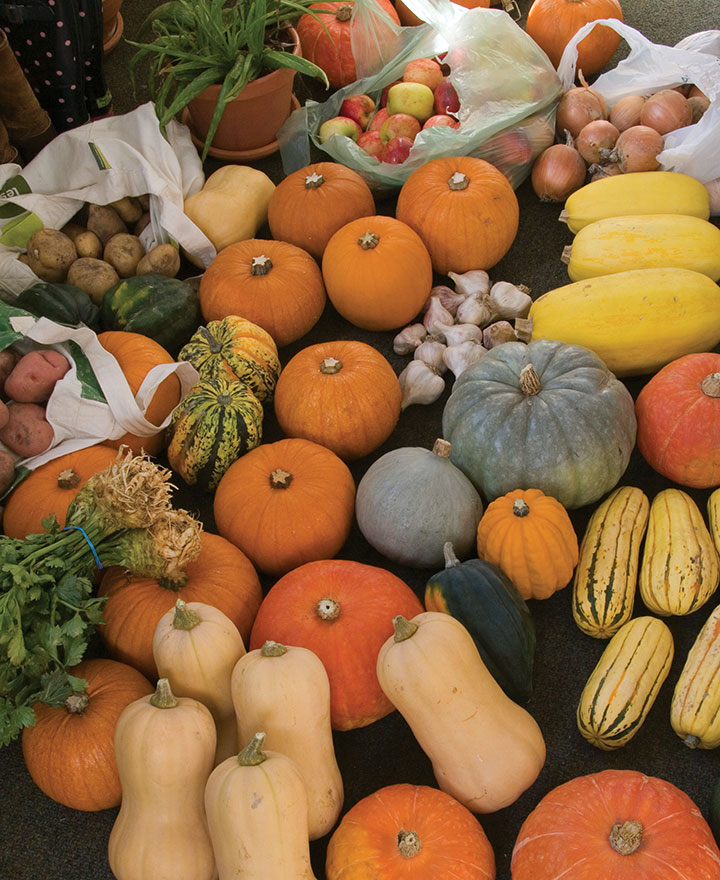
If you had seen our back porch last weekend, you’d probably think we were starting our own farmers market. But this is a typical sight for many seasonal foodies like us; when you swear off strawberries in January, you need enough fresh autumn fruits and veggies to last you until the end of April (notwithstanding my usual February freak-out where I cave in to a craving or two for salad).
We still have quite a ways to go yet, but we’re working hard to fill our root cellar, attic, freezer and pantry shelves with a wide variety of staples and goodies to keep our winter diet interesting. Here’s what we’ve got so far:
In the root cellar:
– 20 lbs. onions
– 10 lbs. apples (still need 2 bushels)
– 10 lbs. potatoes (still need at least 80 lbs., plus a bushel of carrots and parsnips)
– 9 bottles of wine
In the freezer:
– 4 lbs. locally cured, nitrate-free bacon
– 5 whole, local “Rosie” chickens
– various cuts of local, organic meat
– various cuts of venison, provided by my father-in-law
In the refrigerator:
– 5 lbs. fresh cranberries (for canning; more to come)
– 2 or 3 red cabbages
– 6 or so honeycrisp apples (which don’t keep long but are my favorite kind)
– 1 bunch celeriac root now in my belly—yum!
– 1 lb. garlic
In the pantry:
– 25 lbs. rolled oats
– 5 lbs. steel-cut oats
– 10 lbs. coarse-ground grits (not local, obviously, but the mill is definitely a mom n’ pop operation)
– at least 6 different kinds of rice
– 30 lbs. sugar (mostly for canning)
– 3 quarts local, single-source honey
– 15 or so different varieties of loose-leaf tea
The Tailor’s 2009 home preserving yield to date:
– 5.5 quarts dried blueberries
– 6 pints blueberry syrup
– 5 pints canned whole blueberries
– 9 pints blueberry jam
– 9.5 pints blackberry jam
– 8.5 pints raspberry jam
– 6 pints strawberry jam
– 15 pints canned heirloom tomatoes
– 16 pints tomato sauce
– still to come: apple butter, apple sauce, cranberry sauce, chicken broth
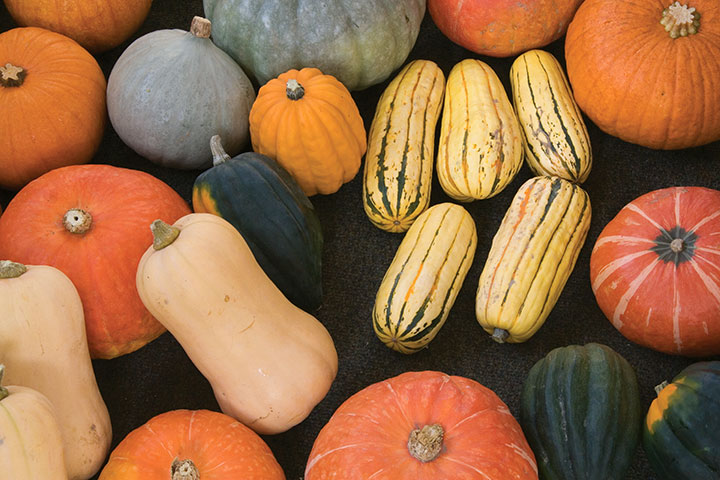
And then there’s the winter squash in the attic: one of my favorite parts of the season, and of living and eating in the Pacific Northwest.
In the attic:
– 14 sugar pie pumpkins
– 8 kabocha squash
– 7 delicata squash
– 6 carnival squash
– 7 acorn squash
– 6 butternut squash
– 3 spaghetti squash
– 1 mini hubbard squash
– 1 jarrahdale pumpkin
Okay, we might have gone a little overboard on the squash, but I never get tired of it, and it’s an important staple of a seasonal diet. We keep these babies in the attic because they last much longer there—pumpkins and squash prefer a cool, dry environment to the cool humidity of the cellar. Our squash colony is a big conversation piece, and we get a lot of questions about pumpkin storage, so I’ll share the scoop:
First, choose squash and pumpkins with intact stems—those that have had their stems snapped off won’t last long. Next, make sure your squash was harvested before the first hard freeze; post-freeze specimens rot fast. Check around the stem and on the bottom end for any mold, rot, blemishes, damage, or sogginess. Now it’s time to sock them away—an attic is best, but anywhere that’s cool, dry and dark will work fine (but never let them freeze! During a cold snap last year we had to haul them all down into the living room when the attic hit 32 degrees!). Don’t stack your squash; just like apples, a rotten squash can infect any neighbors it touches. Instead, we make little “nests” for them by crumpling up newspaper and cushioning each one individually, in a single layer. As long as they’re unblemished and in good shape, and stored carefully, many varieties will last until at least March. Spaghetti squash will often keep until April, but sadly, butternut (my absolute favorite) tends to have the shortest lifespan. So eat those first, and relish every bite.
I feel like a little pumpkin pie. How about you?
October 11th, 2009

Autumn is, hands-down, my favorite time of year. So many of the things I love about fall have to do with food (mulled cider, pumpkin pie, spiced apples, butternut squash, fried green tomatoes, celeriac—the list goes on and on), and since the Tailor and I eat as seasonally and locally as we can, it’s a darn good thing we live in a state with such abundant produce at hand.

Both T-town and Seattle have incredible open-air markets (hello, Pike Place? I love you.), but my favorite of all is the quietly-unassuming Olympia Farmers Market. Our state capital might not be the hoppin’ tourist hub that downtown Seattle is, but Olympia’s gigantic, spectacular market is one of the best I’ve ever seen, anywhere.
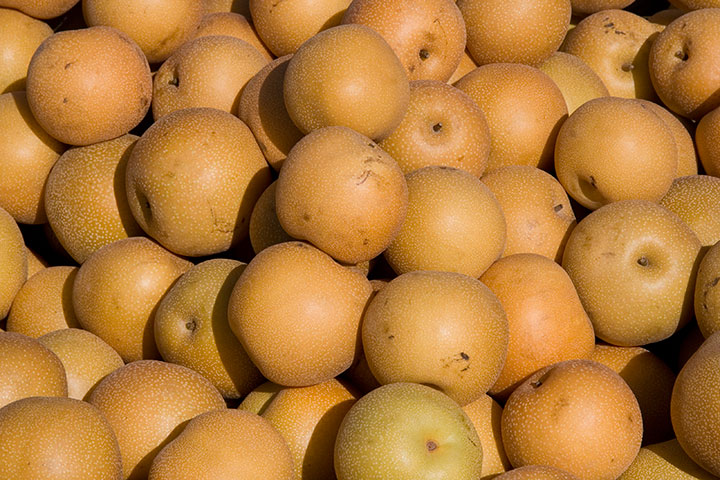
This is the place where you can find around forty different types of Washington apples, and another dozen or so kinds of pears (above are Asian pears, which count as honorary apples in my book).
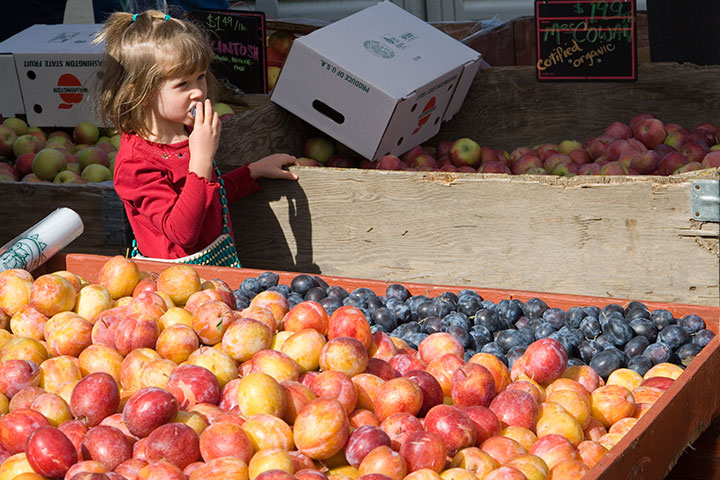
And there’s plenty of everything else, too. The sheer variety is staggering, and distracting—especially when your mission for the day is to buy just one variety of overwintering apples for your root cellar.
Though I must say, I love seeing the transformation from this:
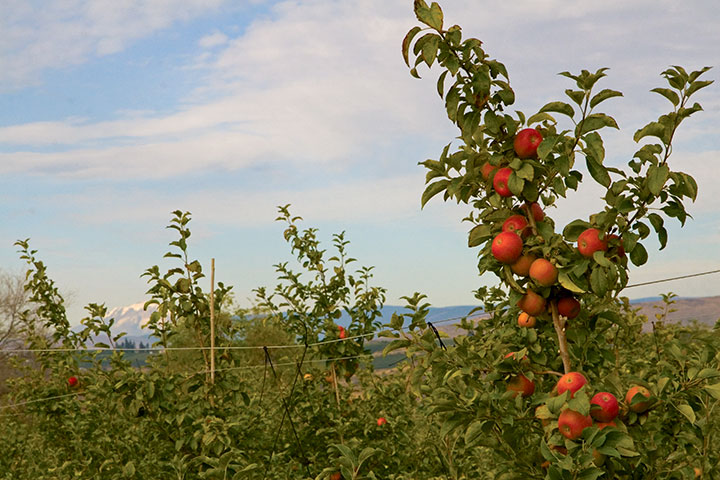
To this:

Ingredients for a perfect Sunday: crisp sunny weather, countless apple bins to dig through, a handful of friendly Olympians, and a dash of live bluegrass music for spice.
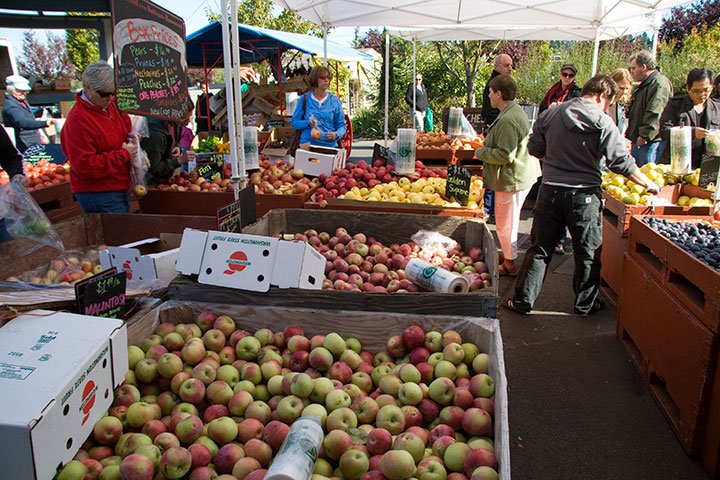
The apples are always a show-stopper, but our biggest goal for the day was something we can’t get at any of the three Tacoma farmers markets:
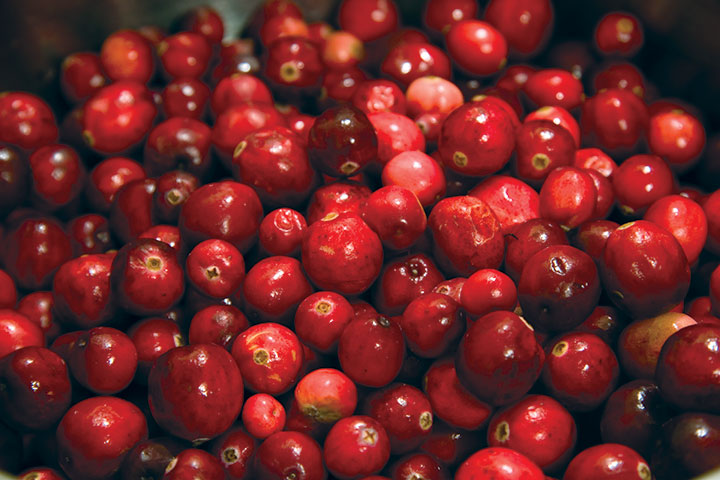
Fresh cranberries. Olympia is the first stop for cranberries coming in from the coast, and the season is now in full swing. We took home just five pounds this time, but you can bet we’ll be back for more. The Tailor and I have a deep and abiding love for cranberry sauce (it’s great on grits. Don’t look at me like that.), and we kicked off this year’s harvest by finishing off the last jar of our 2008 canning crop.
Homemade cranberry sauce is an incredibly easy thing—so much so that I really don’t understand why so many recipes call for Jello. Cranberries have so much natural pectin in them that with enough sugar they’ll jell on their own. In any event, the Tailor and I believe that cranberry sauce should be a sauce, not a can-shaped cylinder of jelly. So in honor of those little rubies from our rugged coast, here is our favorite recipe:
Cranberry sauce
– 1 lb. fresh cranberries, washed and drained
– 2 c. water
– 1 1/2 c. sugar
Combine the water and sugar and bring to a boil in a small saucepan. Boil for about two minutes on high before stirring in the cranberries. Put the lid on and listen; when the cranberries start popping like crazy and the sauce has begun to foam up, it’s done. This takes less than five minutes. Serve hot or cold (or on grits!).
Note: remember to put that lid on, or you’ll have hot, popping cranberries everywhere!




![Chandler O'Leary [logo]](https://chandleroleary.com/wp-content/themes/chandleroleary/images/logo.png)






























